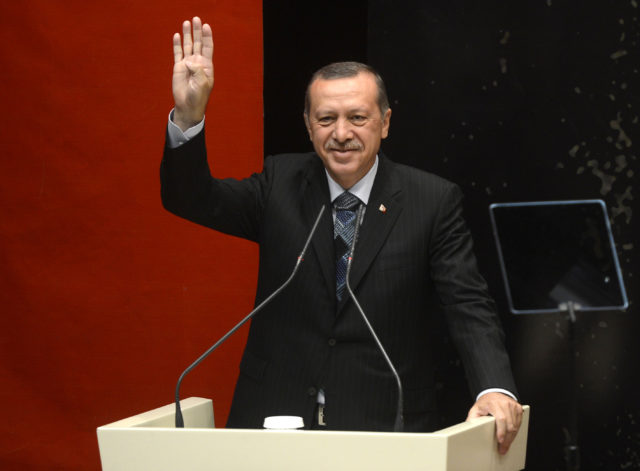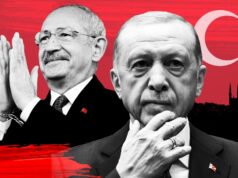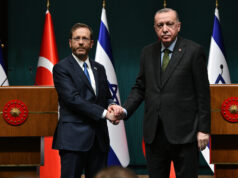When tanks blocked bridges in the heart of Istanbul and F-16s bombed Turkey’s parliament in Ankara last summer, Western diplomats were caught by surprise. So too were U.S. forces stationed at the Incirlik Air Base in southern Turkey. The U.S. intelligence community had no inkling that anything was amiss until the troops started moving. Once forces loyal to Turkish President Recep Tayyip Erdogan had put the attempted takeover down, he took to the airwaves and called the coup attempt “a gift from God” because it provided an excuse to crack down on competitors and opponents. Using enemies lists prepared well in advance, his purges have touched more than 100,000 and sparked widespread conspiracy theories among Turks that the July 15 coup was Turkey’s equivalent of the Reichstag fire, a manufactured crisis meant to allow a dictator to consolidate power. The transformation now underway in Turkey appears consistent with an agenda Erdogan has long worked to implement, secretly at first but with increasing boldness now.
Why have Americans so consistently misread Turkey and Erdogan, its leader since 2003? Long after Erdogan’s implementation of a program to transform Turkey into an authoritarian, Islamic state, senior American officials were describing Turkey as a model for the Muslim world and Erdogan as a democratic reformer.
Credulity and Obliviousness
There are two main reasons for such persistent error: credulity and obliviousness to history. Too many Americans amplify a narrow slice of elite, westward-looking Turkey into a representation of the whole. When Americans visit Turkey’s Mediterranean and Aegean coasts or tourist-friendly and trendy Istanbul neighborhoods, they see a Turkey foreign to most Turks and resented if not disdained by Erdogan and his allies. Erdogan was born in Kasimpasa, a poor Istanbul neighborhood, but spent his formative years in Rize, a small, impoverished Black Sea town in eastern Turkey.
Furthermore, the problem is not only what Americans see, but what they hear: Too many diplomats, politicians, and journalists have a bad habit of believing what interlocutors tell them, especially if they speak the language of Western liberalism. Even after Erdogan began subtly shifting Turkey’s orientation from West to East, American officials remained largely in denial. Gullibility and naiveté are bad enough, but combine it with a failure to appreciate history and the result is toxic both for policy and analysis.
Americans have a very different conception of history than almost any other people on earth. Americans consider anything more than a decade ago to be the distant past, and think nothing of moving a thousand miles away. In Turkey—and much of the rest of the world—it’s the opposite: People are hard-pressed to move 10 miles from their family but consider the last thousand years as yesterday. Put another way, most Americans focus on the future unencumbered by slights suffered by their grandparents, great-grandparents, or co-religionists whom they have never met, but men like Erdogan nurse ancient grudges as if they suffered the slights personally. Erdogan sees himself on a mission not only to right what he considers to be historical wrongs in Turkey, but also to promote Sunni Islam worldwide.
Erdogan and Ataturk’s Turkey
Erdogan hates Mustafa Kemal Ataturk, the founder of modern Turkey and its ruler from 1923 to 1938, for all the reasons so many westward-looking Turks embrace him: Ataturk sought to break from the Ottoman past, relegate the caliphate to history, and place Turkey firmly in Europe. More than nine decades later, it remains just as polarized as the day when Ataturk declared a republic and separated mosque and state. The 62-year-old Erdogan never knew Ataturk—Turkey’s founding father died 16 years before Erdogan was born—but Erdogan, a product of Turkey’s long-marginalized Imam Hatip religious school system, harbors a grievance against the secularist icon as strong as if Ataturk had wronged him personally. “One ought not to stand [in respect, stiff] like a straw on Ataturk’s commemoration events,” he declared in 1994, shortly after becoming Istanbul’s mayor. Eleven years later, Erdogan changed the traditional backdrop for the prime minister’s monthly television address from the Turkish flag and a portrait of Ataturk to photos of Ataturk’s mausoleum and a mosque. The message was clear. Ataturk was dead, but Islam lived on.
Erdogan and his followers do have legitimate reasons for grievance. Ataturk was a progressive, but he was no man of peace. He presided over an authoritarian state and put down by force anyone who opposed his outlook, leaving behind a trail of tears far from forgotten by those with whom he crossed paths. His rule was marked by numerous uprisings—both religious and ethnic—by those opposed to his desire to reorient Turkey toward the West. Few Americans hold grudges for events that occurred during the Hoover administration, but for Turks or Kurds whose ancestors suffered for their religiosity or ethnicity, wounds still fester. In 2015, the AKP and the pro-Kurdish Peoples’ Democratic Party (HDP), both opposed to Ataturk’s vision, won 60 percent of the vote. When Erdogan whips up mobs against secularist, pro-Western Turks in Istanbul and elsewhere, he is as much seeking historical vengeance as contemporary gain. The same holds true for his apologies: He has apologized for state-sponsored atrocities such as the 1937 Dersim massacre perpetrated against Turkey’s Kurds, but he systematically ignores or excuses Islamist atrocities, such as the 1993 Sivas massacre, perpetrated by Sunni Islamists against Shiite Alevis.
After Ataturk
Ataturk died on November 10, 1938, and was immediately succeeded by his longtime prime minister and aide, Ismet Inonu who, like his mentor, ruled over Turkey with an iron fist. In 1950, however, he lost big in Turkey’s first somewhat free election. The Democrat Party’s Adnan Menderes immediately began to consolidate power, undermine military influence, and began slowly to reverse some of Ataturk’s reforms. He allowed muezzins, for example, to call Muslims to prayer in Arabic rather than Turkish and generally gave religious conservatives more space.
At 3 a.m., on May 27, 1960, Colonel Alparslan Turkes led a bloodless coup and arrested Menderes, top ministers, and senior Democrat Party officials. Over subsequent days, the junta forced more than 3,000 officers to retire and fired more than 1,000 university professors and 500 judges, most without evidence of any malfeasance. After a yearlong trial on charges of treason, violating the constitution, and misusing public funds, the military government hanged Menderes and two top ministers. Erdogan later recalled watching his father cry as the six-year-old when Menderes was hanged.
The military staged coups again in 1971, 1980, and 1997. In the former two, the military acted against the backdrop of political paralysis, social tension, and political violence. In the most recent case, it moved to force the resignation of Necmettin Erbakan, a staunch Islamist and Erdogan mentor who sought openly to privilege Islamism at home and abroad.
Each coup influenced Erdogan. He was studying in an Imam Hatip school—an Islamic religious school—in 1971, as the military-backed government rounded up members of radical left-wing groups, both Kurdish and Turkish, while death squads allegedly affiliated with the military began to target a wider array of opposition. The government declared martial law in 11 provinces the following month and cast a wider net in its roundup of students, activists, and political opposition. Torture was commonplace, and Turkey’s jails filled with political prisoners.
In 1980, he was a young activist in the National Salvation Party (Millî Selamet Partisi) when General Kenan Evren overthrew the government. While that action surprised no one—the military had been debating and planning its move for months—the aftermath took repression to a new level. The military may have executed only 50, but it detained at least a quarter million people and some say it may have jailed twice that number. It blacklisted another million Turks from government employment. There was no due process; the military’s suspicion trumped evidence. It was a formative period for the politically ambitious Erdogan.
The 1997 coup touched Erdogan more directly. After the military forced Erbakan’s resignation, it closed religious schools, shuttered businesses owned by prominent Islamists, and disbanded the Welfare Party. Many of those with close ties to the ousted premier found themselves targeted by prosecutors for offenses real or imagined. At the time, Erdogan was mayor of Istanbul, but a religious-incitement charge landed him in prison and led to what at the time was billed a lifelong ban on politics.
Erdogan’s Rise
The AKP’s 2002 triumph, and Erdogan’s rise to the premiership months later, might have healed decades of political wounds if Erdogan had generosity of spirit. He convinced many Americans that he had turned the page. Erdogan talked about his brief imprisonment as a time for maturation, and close aides told Western journalists, diplomats, and members of Congress that Erdogan had learned from the mistakes of the past and appreciated the importance of working across party lines and respecting constitutional parameters. In reality, Erdogan wanted revenge.
His enemy lists were long and detailed. They included not only those who criticized him during his reign but also those who crossed his friends and allies in the years prior to his holding office. He stacked Turkey’s Savings Deposit Insurance Fund, an important banking regulatory board, with party and personal loyalists and used it to target businessmen and companies with a long record of support for party rivals. A year into his first term, Erdogan used the board to seize 219 companies belonging to a rival in the 2002 elections. He likewise wielded Turkey’s tax agency as a weapon against Turks who donated to or were perceived to support rival parties. In February 2009, chafing at the refusal of its media companies to toe his party line, Erdogan-controlled tax authorities fined the conglomerate Dogan Group, owner of several newspapers, $500 million. When the company continued its criticism, the government slapped another $2.5 billion fine on it just seven months later.
He has reserved special ire for journalists. From his first days in office, Erdogan has harassed journalists and their editors with lawsuits for transgressions as mild as lampooning him in political cartoons or paraphrasing rather than replicating verbatim speech excerpts in tweets. According to Reporters Sans Frontières, Erdogan’s Turkey has arrested more journalists per capita than any other country, including China and Russia. What makes Erdogan’s repression so scary, however, is that it is not just reactive but proactive. When the Turkish leader arrived at the Brookings Institution, a 100-year-old Washington think tank, on March 31 to address an invited group of journalists, academics, and analysts, Erdogan’s personal security, before the event even began, accosted and tried to remove audience members Erdogan believed might question his platitudes and assertions.
As Erdogan grew more confident, he cast a larger net. He often used fabulist coup plots as a reason to crack down. In 2007, for example, his government launched an investigation into the so-called Ergenekon conspiracy, in which prosecutors alleged that several hundred secularists planned to incite political violence as a pretext to a military coup. Over the next 13 months, police detained hundreds of suspects, holding most incommunicado and refusing them access to lawyers. By February 2011, indictments surpassed 8,000 pages; Turkey’s courts ultimately overturned convictions for lack of evidence.
In 2010, the liberal, anti-military Taraf newspaper published claims of another conspiracy, the so-called Sledgehammer (Balyoz) affair. Once again, Turkish police rounded up hundreds of suspects. Harvard Professor Dani Rodrik, the son-in-law of Cetin Dogan, a prominent general named in the plot, noted that the smoking-gun computer files upon which the government’s case rested were written in a Microsoft Word version that had not existed when the plan was allegedly hatched. Ultimately, this case too collapsed.
Erdogan also sought to turn past purges on their heads. Railing against the 1980 coup became a staple of his castigation of the military. In 2010, the AKP amended the constitution to allow the perpetrators of the coup to stand trial. When, two years later, he placed Evren in the dock, Erdogan celebrated: “With the support of the people, we have . . . allowed the judiciary to fulfill its duty and start the coup trial process.” Five hundred witnesses from across the political spectrum registered to recall their suffering and exact revenge on their tormentors. In some cases, however, justice delayed was just as spurious as that which occurred after Evren’s coup.
Turkey Today
This brings us to the present. The scale of Erdogan’s purge may soon surpass that of 1980. The smoke had not even cleared before Erdogan announced the arrest of not only 8,000 soldiers, including one-third of Turkey’s flag officers, but also another 7,000 civilians. Within hours, the government had suspended or detained almost 3,000 judges, revoked the licenses of 21,000 teachers, and laid off an additional 15,000 from the education ministry. It dismissed 8,000 policemen, sacked more than 1,500 university deans, and fired several thousand more spread across Turkey’s 21 ministries. Turkish police even arrested 60 children on charges of treason. Every day, the Turkish press reports new arrests and firings. Erdogan has no intention to limit the purge to state employees, however. Ali Babacan, a longtime Erdogan aide and former foreign and finance minister, said on July 31 that the government would also “cleanse” the private sector. “There is no room for us to take any risk here. This cleaning process must be without mercy,” he told CNN Turk.
With Erdogan’s opponents on the run and an iron grip on all mechanisms of state, what comes next? In 1994, while still mayor of Istanbul, he declared, “Thank God Almighty, I am a servant of the Sharia” and, the following year, called himself “the imam of Istanbul.” That was the unvarnished Erdogan. He may have promoted an illusion of reform and refinement after the 1997 coup and his subsequent imprisonment, but he has now shed that pretense and embraced an agenda he has nurtured his whole life. He aims not only for power and money but also seeks to achieve a larger goal: the complete reversal of Ataturk’s reforms. In 2012, Erdogan declared his goal was “to raise a religious generation.” That same year, doctors diagnosed him with colon cancer and gave him only two years to live. Erdogan might have beaten that prognosis, but he is conscious that his time is not infinite. He wishes to see Turkey celebrate its centenary in 2023 not as the secular state envisioned by Ataturk but as an Islamic Republic.
Michael Rubin Ph.D., is a resident scholar at the American Enterprise Institute and a former Pentagon official.






